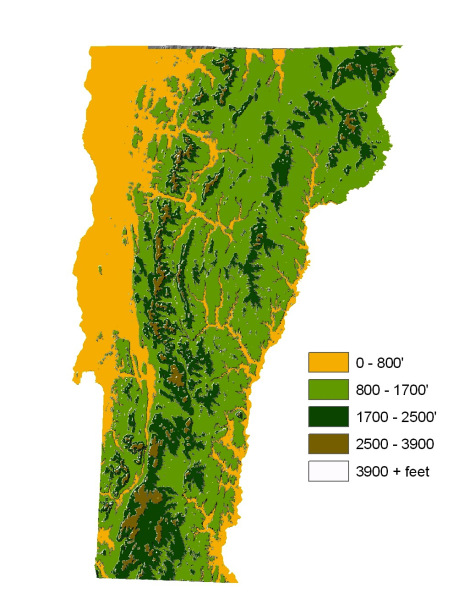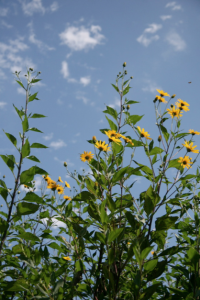Focal Places in Burlington
The Intervale
In Vermont today, the word “Intervale” is closely associated with the Intervale Center in Burlington. The word has a much wider and older history, however, used by European colonists to describe the rich, narrow floodplain valleys that weave across the New England landscape. *Abenaki Indians had two words for these landforms: Pasahana described an intervale running east to west (such as the Winooski River), and Wolhana described a north-south running intervale (such as the Connecticut River). These river valleys are rich for exploring both the ecological and social history of the region.
Intervales weave through the mountains of Vermont, visible on the map below in yellow. The Champlain Valley’s flatter topography also appears yellow in this map, but contains the western extension of four major intervales – running south to north, Otter Creek and the Winooski, Lamoille, Mississquoi river valleys – which originate in the Green Mountains to the east.

Over time, intervales have shaped the people who’ve inhabited and used them, and human land use has in turn changed the intervales.
Intervales In New England
Human history in New England’s river valleys goes back at least 14,000 years, when people travelled north following the melting of glaciers and inhabited the newly exposed tundra landscape. Early inhabitants of New England hunted big game animals, fished in rivers and along coastlines, and gathered wild plants as food, medicine, and technology. As the climate warmed and Ice Age megafauna went extinct, human communities shifted their lifeways towards horticulture, agriculture, and semi-permanent settlements. This new pattern of settlement and land use was concentrated along coastlines and around intervales.
The rich alluvial soils redeposited in floods generation after generation, milder climate at low elevations, abundance and diversity of river & floodplain ecosystems, and ease of travel by foot and boat, made intervales the “common pot” of native communities throughout New England. In particular, the long growing season and rich soils made intervales much more suitable for agriculture than upland sites.

Intervale Sunchoke
Traditional land use in intervales included:
- Diverse annual and perennial crop agriculture
- Burning to maintain meadows and prairies
- Harvesting wild food, medicine, and tool crops from floodplain forests
- Hunting game animals, and managing their habitat through clearing and fire
- Managing nut groves (butternut, hickory, chestnut, oak) through clearing and fire for tree health, mast size, and understory crops
- Fishing with spears, nets, weirs, and traps
* Special thanks to Judy Dow for her contributions of information about Abenaki history and language.
To learn more about the ancient history of New England people, Frederick Matthew Wiseman’s The Voice of the Dawn and Reclaiming the Ancestors, as well as William Haviland’s The Original Vermonters are excellent resources.